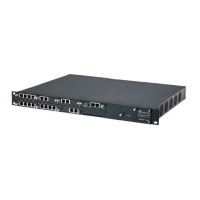SIP User's Manual 846 Document #: LTRT-12804
Mediant 800 MSBG
Parameter Description
AltRouteCauseIP2Tel 1 = 1 (Unallocated Number)
AltRouteCauseIP2Tel 2 = 17 (Busy Here)
Notes:
This parameter can include up to 5 indices.
If the device fails to establish a call to the PSTN because it
has no available channels in a specific Hunt Group (e.g., all
the channels are occupied, or the spans are disconnected or
out-of-sync), it uses the Internal Release Cause '3' (No
Route to Destination). This cause can be used in the
AltRouteCauseIP2Tel table to define routing to an
alternative Hunt Group.
This table can be used for example, in scenarios where the
destination is busy and the Release Reason #17 is issued or
for other call releases that issue the default Release Reason
(#3).
The device also plays a tone to the endpoint whenever an
alternative route is used. This tone is played for a user-
defined time (configured by the parameter
AltRoutingToneDuration).
For an explanation on using ini file table parameters, see
''Configuring ini File Table Parameters'' on page 368.
Web/EMS: Forward On Busy Trunk Destination
[ForwardOnBusyTrunkDest]
This ini file table parameter configures the Forward On Busy
Trunk Destination table. This table allows you to define an
alternative IP destination - IP address or SIP Request-URI user
name and host part (i.e., user@host) per Hunt Group for IP-to
Tel calls. The IP-to-Tel call is forwarded to this IP destination
(using 3xx response) if the following exists:
The format of this parameter is as follows:
[ForwardOnBusyTrunkDest]
FORMAT ForwardOnBusyTrunkDest_Index =
ForwardOnBusyTrunkDest_TrunkGroupId,
ForwardOnBusyTrunkDest_ForwardDestination;
[\ForwardOnBusyTrunkDest]
For example, the below configuration forwards IP-to-Tel calls to
destination user “112” at host IP address 10.13.4.12, port 5060,
using transport protocol TCP, if Trunk Group ID 2 is
unavailable:
ForwardOnBusyTrunkDest 1 = 2,
112@10.13.4.12:5060;transport=tcp;
When configured with user@host, the original destination
number is replaced by the user part.
Notes:
The maximum number of indices (starting from 1) depends
on the maximum number of Hunt Groups.
For the destination, instead of a dotted-decimal IP address,
FQDN can be used. In addition, the following syntax can be
used: "host:port;transport=xxx"(i.e., IP address, port and
transport type).
For a detailed description of this feature, see Configuring

